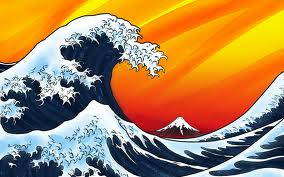Interested in wave art from Japan? Find out about the Japanese wave art that caused ripples in the global market.
Japanese wave art is a phenomenon that started to flourish in the 1920s. The particular artist strongly associated with wave art is Katsushika Hokusai. Although he was a Japanese artist his expertise lay in Chinese painting. He is known for a number of important works with the most prominent of his achievements being the thirty six views of Mount Fuji. It is in this collection that the great wave of Kanagawa was showcased.
This particular series was created by Hokusai as a result of the boom in the domestic travel industry and not to mention the artist’s obsession with the mountain. The Great Wave then became the identity forming work for the artist. The Western world in particular went head over heals over the Great Wave which led to worldwide recognition of Hokusai and the print.
Hokusai had a very interesting and colorful early life. One of the things uniquely attributed to Hokusai throughout his life is the number of names that were given to him which were around thirty. From a wood block apprentice to a qualified professional artist Hokusai slowly and gradually worked his way up to becoming one of the most formidable artists of his time.
In the span of his career Hokusai is credited with producing a wide collection of brush paintings. They were known by the name of surimono. He also worked on a number of illustrations for the kyoka ehon. Eventually he broke away from the school in order to become an independent artist.
From this time onwards he began to produce independent works of art that are part of his collection. As a result of his work he began to attract young aspiring artists who wished to study under him in order to grow. The next decade of his life brought him immense success because not only was he a talented artist, he had an amazing nag for self publicizing.
It was however the Great Wave that brought the artist unprecedented success. By means of the success that his wave art got him people began to take interest in his previous work as well. Critics argue that the famous Japanese wave art was very unorthodox for the art of that time in Japan. This is perhaps one of the reasons why it was so appealing to the masses. The appeal of the Great Wave was not restricted to the boundaries of Japan rather the whole world was fascinated by this amazing piece of art.
Hokusai caused a revolution with his wave art. He started a trend in Japan where wave art was being incorporated in other forms of art. Logos, T-shirts, decoration items such as wall hangings and posters of wave art began to spring up. In fact they are ever more popular today. Japanese tattoo artists have also been inspired by the Great Wave and have sought to capture the essence and style of the wave in their own field of art.





